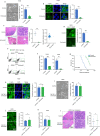YAP silencing by RB1 mutation is essential for small-cell lung cancer metastasis
- PMID: 37739954
- PMCID: PMC10516997
- DOI: 10.1038/s41467-023-41585-z
YAP silencing by RB1 mutation is essential for small-cell lung cancer metastasis
Abstract
Small cell lung cancer (SCLC) is highly lethal due to its prevalent metastasis. Most SCLCs have inactivating mutations in TP53 and RB1. We find that loss of YAP expression is key for SCLC cells to acquire rapid ameboid migration and high metastatic potential. YAP functions through its target genes CCN1/CCN2 to inhibit SCLC ameboid migration. RB1 mutation contributes to YAP transcriptional silencing via E2F7, which recruits the RCOR co-repressor complex to YAP promoter. We discover that benzamide family HDAC inhibitors stimulate YAP expression by inhibiting the RCOR-HDAC complex, thereby suppressing SCLC metastasis and improving survival in a mouse model. Our study unveils the molecular and cellular basis underlying SCLC's high metastatic potential, the previously unrecognized role of YAP in suppressing ameboid migration and tumor metastasis, and the mechanism of YAP transcription regulation involving E2F7, RCOR, and Sin3 HDAC. This study reveals a therapeutic potential of benzamides for SCLC treatment.
© 2023. Springer Nature Limited.
Conflict of interest statement
K.-L.G. is a co-founder of and holds an equity interest in Vivace Therapeutics. All other authors declare no competing interests.
Figures






References
-
- Ott PA, et al. Pembrolizumab (MK-3475) in patients (pts) with extensive-stage small cell lung cancer (SCLC): Preliminary safety and efficacy results from KEYNOTE-028. J. Clin. Oncol. 2015;33:7502. doi: 10.1200/jco.2015.33.15_suppl.7502. - DOI
Publication types
MeSH terms
Substances
Grants and funding
LinkOut - more resources
Full Text Sources
Medical
Research Materials
Miscellaneous

